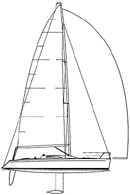Synergy 1000
One designr
The hull shape shows a reverse sheer. This has advantages. It reduces windage in the bow, and puts the max freeboard where it will do the most good, below in the accommodations. There may also be a structural advantage to reversing the sheer as it then opposes the hull's fore and aft bending loads. I know that Tom Wylie uses the reverse sheer for this precise reason. It doesn't look bad either.
The D/L of this design is 79. The keel is a steel fin engineered by my old roommate Craig Goring of Friday Harbor. There is a 1,850-pound lead bulb molded onto the bottom of the hollow steel fin. Note the keel is well aft on this design, helping to balance the huge mainsail. Draft is 7 feet. The hull form looks on the full side from the deck plan, but I can assure you this hull is anything but full. The entry is hollow and topsides are flattish and flared. It's a very fast-looking shape.
The rig is big and designed specifically to be used without genoas in the light airs that dominate Seattle's summer. The spreaders are swept aft 22 degrees. The rig is carbon fiber. The SA/D is 33.96Ñsay 34. This is a lot of horsepower per pound. I would guess this boat would be very fast accelerating off the starting line. With its near masthead asymmetric chute this boat wants to start to plane in 10 knots of true breeze.
Obviously this is not a cruising boat. I'm not sure why they bother with accommodations at all except you might want to sleep part of your crew while you are away at a race week. Maybe you want to cruise for a couple of weeks. There is no reason why you couldn't cruise this boat. This is a little boat. The head is in the V-berth area and there is really no galley. There is a nice big chart table so you will know exactly where you are when you starve. My 26-footer has at least as comfortable a layout as this 32-footer. To be fair my 26-footer weighs an additional 1,200 pounds.
One of the cleverest features of this design is the auxiliary. The Honda Four Saildrive 280 is a 12.5 horsepower, four-stroke, gasoline-powered Honda outboard motor head with a saildrive unit. This is a quiet, smooth and especially light way to power this boat. It weighs 110 pounds, everything included. The Honda drives the Synergy effortlessly at 8 knots. Note this month that three out of the four reviews use saildrives. Saildrives offer the lowest drag of any propeller installation.
Construction uses a male mold and composite construction with wood, foam, carbon fiber and glass. This produces a very strong and stiff sandwich with panel weights around 1.5 pounds per square foot.
Regular readers will know by now what I think of one-designs. If there is to be any momentum behind a new class it will come from boat performance and not ad hype. People will flock to a new, hot boat. They won't buy a dog just because they think there will be another 10 of them on the starting line. From all I can see at this early juncture, the Synergy 1000 will attract a vital group.

Comments